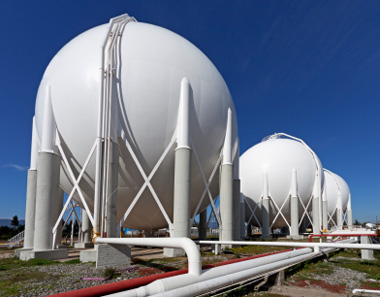A natural gas is called sweet gas if it has no sour components such as H2S, CO2, mercaptans, but is almost exclusively composed of methane, low amounts of ethane, propane, inert gases (N2) and traces of heavier
hydrocarbons. It is generally saturated in water at reservoir temperature and pressure.
A natural gas is usually defined as sour when it contains hydrogen sulphide (H2S) and/or carbon dioxide (CO2).
A condensate gas reservoir can be defined as a reservoir in which temperature is between critical temperature and cricondenthermal point (maximum temperature at which coexistence of the two phases is still possible) for the particular natural hydrocarbon system it contains.
At this point it is useful to outline a phase diagram of a natural hydrocarbon system.
In a natural hydrocarbon reservoir, within the porous bed that makes up the source rock, we will find hydrocarbons of aliphatic, aromatic and naphthenic type, ranging from low molecular weight terms (like methane) to sometimes, very high molecular weight terms (crude oil), together with minor amounts of some non hydrocarbons (CO2, N2, H2S etc.).
Formation water is almost always present in the reservoirs.
In the reservoir, the fluids can be present as a single phase gas (a gas reservoir), single phase liquid (an under-saturated petroleum reservoir) or two distinct phases (a petroleum reservoir with an overlaying gas cap).
The points along the line AC represent liquid at incipient vaporization i.e first vapour bubble formed, and constitute the “bubble point” curve. (Fig. above) The points along the CB curve represent vapours at incipient condensation
i.e and constitute the “dew point” curve.
From the diagram we can observe that a pressure decreasing, for temperatures between Tc and Tc’, that cross the dew point curve, causes the appearance of dew (drops of liquid) in the initially homogeneous gaseous phase. Bubble point and dew point curves cross at point C, known as the critical point of the system, corresponding to critical temperature and critical pressure. In a multi-component system the coexistence of liquid and gaseous phases is possible even at temperatures above critical temperature. Therefore, it is preferable to define as critical, such a state in which all the intensive properties (density, compressibility, viscosity, etc.) of the liquid and gaseous phases are equal.
POINT C’: maximum temperature at which coexistence of the two phases is still possible; it identifies the CRICONDENTHERM state.
POINT C”: maximum pressure at which both liquid and gaseous phase can coexist; it identifies the CRICONDENBAR state.
The internal AB area of the curve represents the region of coexistence of liquid and gaseous phase. The dotted curves inside this area connect points of equal percentage of liquid phase.
By reducing pressure below the dew point value, there is initially an increase of the liquid phase and subsequently a partial or total reevaporation of the phase itself. This phenomenon is known as retrograde condensation and the reservoirs involved in this action are commonly known as condensed reservoirs. The pressure reduction produced by the gas distribution in these reservoirs, that are initially single phase gaseous, causes a liquid phase to appear in the layer.
In the following table, the components of SWEET, ACID and CONDENSED gas fluids are indicated.

